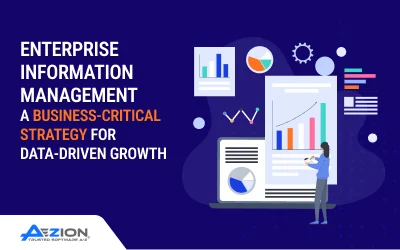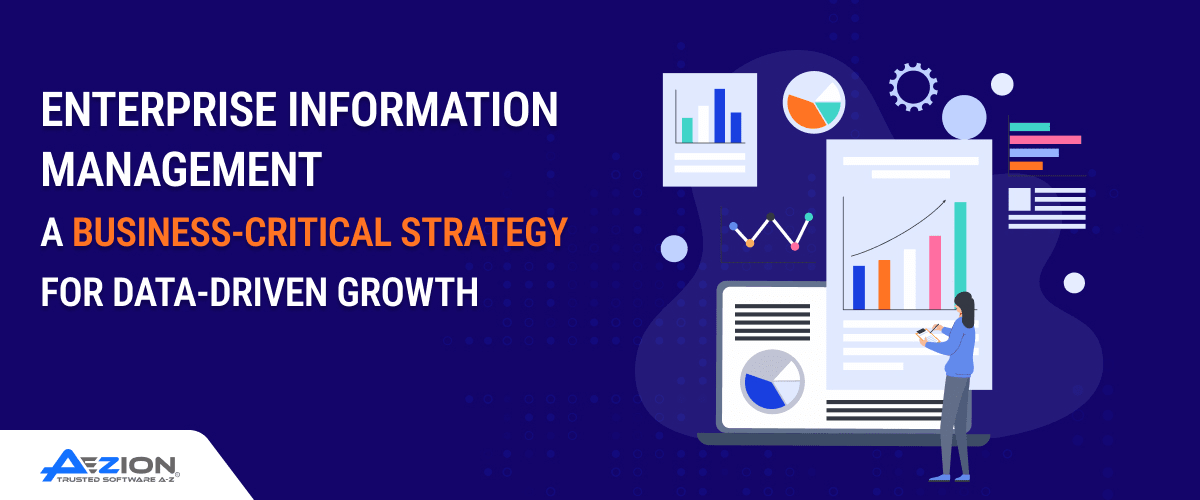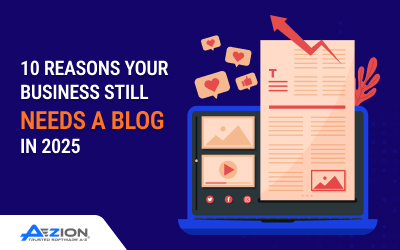Summary
Enterprise Information Management (EIM) is an integrated solution that consolidates data into a strategic enterprise, enabling organizations to maintain accurate, secure, and easily accessible data within their systems. With the integration of governance, master data management, lifecycle management, and metadata tracking, EIM enables organizations to maintain accurate, secure, and easily accessible data within their business. With the digital-first strategy in today’s environment, many data engineering service providers now incorporate EIM into their solutions to help enterprises speed up decision-making through data and regulatory compliance, reduce operational costs, and facilitate scalable cloud-based transformations. In this blog, we will dive deep into the role of Enterprise Information Management.
Introduction
In today’s hyper-connected and data-driven economy, businesses create vast amounts of information, from customer transactions and operations to documents and regulatory records. However, companies will become chaotic without a single strategy for managing, storing, and using this data. That’s where Enterprise Information Management (EIM) comes in and why it’s becoming a core pillar of next-generation data engineering ecosystems.
Data engineers leverage enterprise information management to enable businesses to manage information not as a by-product, but as an asset. This is to make better decisions, adhere to regulations, and be ready for AI. With the generation of cloud-based data management, increasing compliance demands, and the need for quicker insights, effective data management strategies are no longer a choice.
At its core, EIM aligns data analytics and engineering with business outcomes by helping data leaders, architects, and data analytics engineers ensure the correct data reaches the right decision-makers at the right time. This is why the global enterprise information management market size is estimated to reach USD 431.96 billion by the year 2033.
In this blog, we will go through details about Enterprise Information Management (EIM), its importance, strategies, real-world use cases, and more.
What Is Enterprise Information Management (EIM)?
Enterprise Information Management (EIM) is an organized method of obtaining, managing, integrating, and delivering data within an enterprise. EIM combines data governance, metadata management, content management, and information architecture to establish a framework for trusted, accessible, and actionable data.
Unlike traditional data storage or analytics systems, EIM is less about technology and more about people, processes, and platforms working together strategically. EIM becomes a vital layer in any data engineering architecture in an organization.
Key Building Blocks of Enterprise Information Management
Here are some of the main pillars of EIM:
- Data Governance: It formulates policies and standards to ensure data accuracy, security, and compliance.
- Master Data Management (MDM): Maintains consistency of critical data (e.g., customers, suppliers).
- Information Lifecycle Management: Controls data from inception through archiving or deletion.
- Content and Document Management: Stores and manages unstructured data like PDFs, videos, and contracts.
- Metadata Management: Records the context and lineage of data to enable discoverability and trust.
Why Enterprise Information Management Is Essential to Business Success Today?
In a digital-first world, data is at the center of competitive advantage. However, without an overarching strategy to govern and manage data, organizations risk making decisions based on inconsistent, stale, or inaccessible information. This is where Enterprise Information Management (EIM) comes in and can be a game-changer.
1. Drives Data-Driven Decision Making to Greater Speed
With EIM, organizations can dismantle data silos so business leaders and analysts can obtain the correct data at the proper moment. Clean, governed data translates into faster, better operations, finance, marketing, and product strategy decisions.
Example: An international retailer utilized EIM to consolidate sales information from various regions, resulting in a 30% increase in demand forecasting.
2. Supports Regulatory Compliance and Risk Minimization
Data privacy regulations such as GDPR, HIPAA, and CCPA require intense control over business data. EIM enforces data governance policies uniformly across the company, minimizing legal and reputational risk.
3. Facilitates Scalable Digital Transformation
With businesses making their infrastructure cloud-based with data management in the cloud and AI applications, EIM supplies the framework for scalable, secure, and efficient transformation. It is the glue for data engineering services, platforms, and individuals.
4. Richer Customer Experience
EIM-powered unified customer profiles enhance personalization, service delivery, and response time, which are essential for the finance, healthcare, and e-commerce industries.
5. Improves Operational Efficiency
EIM minimizes data duplication, storage, and manual reporting costs by removing redundancies and streamlining information flows.
Whether you’re an expanding business or a large enterprise data services organization, integrating EIM into your data engineering plan is no longer a choice — it’s a necessity.
Real-World Use Cases of Enterprise Information Management Across Industries
Enterprise Information Management (EIM) is not a one-size-fits-all approach — it’s a dynamic, strategic enabler that adjusts to your industry’s data maturity and operational requirements. Across industries, data engineering firms are embedding EIM into digital transformation programs to address complex data issues and drive tangible results.
Healthcare
Health systems and healthcare networks are plagued by siloed patient information in EMRs, labs, imaging, and insurers. With EIM:
- Patient records are consolidated and managed.
- HIPAA compliance is simplified.
- Care teams have real-time access to key health information.
Example: A national health provider deployed EIM with a cloud-based data management model, enhancing clinical decision-making and lowering duplicate testing by 25%.
Manufacturing
Manufacturers require ubiquitous product, supplier, and logistics data across worldwide locations. EIM facilitates:
- Master Data Management (MDM) of inventory and SKUs.
- Predictive maintenance through clean IoT data streams.
- Supply chain optimization.
One multinational producer collaborated with a data engineering firm to create EIM-powered dashboards, cutting delays in procurement cycles by 20%.
Finance
Banks and financial institutions handle enormous customer and transactional data. With EIM:
- KYC and AML data are integrated and managed.
- Risk scoring models are based on reliable data.
- Customer journeys are personalized on a scale.
A fintech customer employed EIM as a component of their data engineering offerings to provide personalized promotions, resulting in a 2x boost in conversion rates.
Retail & eCommerce
Retailers must consolidate POS, online, and customer data for enhanced insights. EIM assists:
- Typo: Unify customer profiles across channels.
- Optimize stock based on real-time demand.
- Power AI-driven recommendations.
An American retail store utilized EIM, data analytics, and engineering capabilities to enhance product assortment choices and increase the revenue per store.
Key Pillars of an Effective Enterprise Information Management Strategy
A successful Enterprise Information Management (EIM) strategy does not begin with tools, but with a clear vision, alignment, and execution across people, processes, and platforms. For organizations collaborating with a data engineering firm, the most effective EIM strategies are those constructed on these pillars of foundation:
Information Governance Framework
Create policies, roles, and responsibilities for enterprise data. This means all datasets from customer data to financials are accurate, secure, and traceable. Governance allows:
- Data quality standards
- Stewardship responsibilities
- Risk mitigation and compliance enforcement
Master and Reference Data Management
Consistency starts here. MDM standardizes essential business data across departments and systems. It allows:
- One source of truth for customers, products, and vendors
- Cleaner, faster analytics
- Interoperability between business units
Cloud-Based Data Management Infrastructure
Today’s EIM requires agile, scalable environments. Cloud-based data management leverages:
- Centralized storage and access
- Support for hybrid/multi-cloud strategies
- Lowering infrastructure overhead with better performance
Metadata and Data Lineage Tracking
Metadata is the map of your data, and EIM requires that context to scale. This pillar encompasses:
- Data classification
- Tracking the usage of data
- Lineage understanding for compliance and trust
Integration with Data Analytics and Engineering Workflows
A successful EIM strategy must be deeply embedded within data analytics and engineering pipelines. This guarantees:
- Smooth transmission of governed data to analytics platforms
- Enablement of self-service BI and training of AI models
- Automation and repeatability in reporting
Common Enterprise Information Management Challenges and How to Overcome Them
Most organizations struggle to implement or scale Enterprise Information Management (EIM) despite its importance in strategy. Success depends on identifying such challenges early and partnering with experienced data engineering firms to overcome them seamlessly.
Data Silos Across Departments
Problem: Departments keep data in various formats, platforms, and systems, hindering integration and analysis.
Solution:
- Take a centralized cloud-based data management approach.
- Utilize data engineering services to consolidate data sources into a shared architecture.
- Encourage cross-functional collaboration through shared governance policy.
Substandard Data Quality and Variable Standards
Problem: Duplicates, stale entries, and non-uniform taxonomies undermine trust in data.
Solution:
- Enforce Master Data Management (MDM) to normalize key entities.
- Leverage automated cleansing tools and data profiling as part of your analytics engineering pipeline.
Executive Buy-In Shortage
Problem: EIM is often viewed as an IT initiative rather than a business imperative.
Solution:
- Position EIM regarding business value — quicker decisions, cost reductions, and compliance.
- Emphasize the success stories of peer or competitor organizations.
Legacy System Complexity
Problem: Legacy systems do not accommodate modern APIs or cloud connectivity.
Solution:
- Employ data engineering capabilities such as data virtualization or integration layers.
- Incrementally modernize using a hybrid model — keep traditional systems in place while reaching out to cloud environments.
Users’ Resistance to Change
Problem: Users resist new workflows or tools because they do not know them or view them as requiring additional effort.
Solution:
- Develop easy-to-use self-service portals.
- Administer EIM onboarding and training.
- Celebrate quick victories to create momentum.
The Future of Enterprise Information Management
Enterprise Information Management is changing quickly to cater to the requirements of next-generation technologies. The destiny of EIM is intelligent automation, AI-based insights, and cloud-native architectures that offer scalable, adaptive, and secure information ecosystems.
AI-powered Data Classification and Enrichment
EIM platforms can automatically classify, tag, and enrich structured and unstructured data using machine learning models. This minimizes human effort and maximizes metadata accuracy requirements for successful data governance and analytics. Data analytics engineers gain from richer, contextual datasets for AI/ML uses.
Semantic Search and Knowledge Graphs
Sophisticated semantic search functionality allows business end-users to naturally discover appropriate data and documents, fueled by knowledge graphs that establish connections throughout enterprise data. This facilitates data discovery and democratization, which are the primary objectives of any data engineering firm dedicated to self-service analytics.
Cloud-first, Decentralized Architectures
The move to cloud-based data management infrastructures persists, with hybrid and multi-cloud strategies facilitating enterprises to balance costs, performance, and compliance. Decentralized data lakes and fabrics provide agility while preserving governance in distributed environments.
EIM as a Digital Foundation for GenAI Adoption
EIM frameworks will be essential to ready data pipelines and environments for GenAI workloads to ensure ethical use, compliance with privacy, and traceability.
These innovations place EIM as the foundation for future-proofed data engineering solutions to help enterprises unlock new business value in a world fueled by AI.
What Aezion Offers in the EIM Space
Aezion applies rich experience in Enterprise Information Management by integrating strategic consulting, custom development, and cloud-native implementations to enable organizations to get the most from their information assets.
Custom Development and Systems Integration
We map your existing data environment and create a roadmap that matches your business objectives and operational KPIs, focusing on quantifiable ROI.
Whether bringing legacy systems together or launching new cloud platforms, Aezion constructs scalable, secure, and interoperable EIM solutions.
Cloud-Native EIM Implementation
Our data engineering involves deploying next-generation data fabrics, metadata repositories, and governed data lakes using top cloud providers for flexibility and scalability.
Frameworks for ROI-Focused Transformation
We prioritize governance, data quality, and analytics enablement to guarantee your EIM program produces quantifiable business results, not merely technology improvements.
Conclusion
Enterprise Information Management is no longer a necessity but a business necessity. Through purposeful data governance through defined frameworks and taking advantage of next-generation cloud-native technologies, organizations can disassemble silos, increase data worthiness, and drive quantifiable business value. To overcome obstacles like legacy complexity and end-user resistance, addressing the complexity in an end-to-end manner with technology, people, and processes is needed. With upcoming innovations in AI-based metadata management and decentralized cloud architecture, EIM is well on its way to becoming the bedrock of future-proof data engineering solutions.
Collaborating with an experienced data engineering provider such as Aezion guarantees that companies not only execute but ultimately leverage EIM to realize new possibilities in an age of data.
Frequently Asked Questions (FAQs)
How does EIM differ from data management or BI?
EIM includes governance, integration, lifecycle management, and storing or reporting information. It’s a strategic style of handling all enterprise information assets.
How long does a typical EIM deployment take?
Deployments vary in scope and complexity but take between 6 and 18 months, assuming assessment, design, implementation, and adoption phases.
Do I need a specific tool or platform?
Success with EIM relies more on governance and strategy than on any one tool. However, key enablers are cloud-native platforms, data fabric architectures, and metadata management tools.
What size companies require EIM?
All enterprise sizes can benefit from EIM, but mid-to-large organizations must cope with sophisticated, distributed data environments and regulatory compliance.
Can Aezion assist with legacy system modernization?
Indeed, we specialize in modernizing aging data infrastructure with incremental cloud adoption, data virtualization, and API-driven architecture while maintaining continuity.




